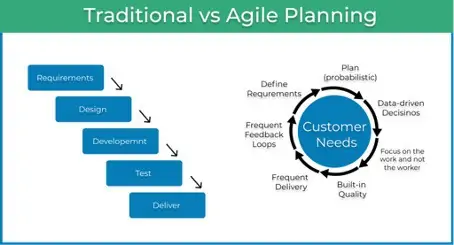The agile approach is one of the most popular methodologies among project managers these days. This agile project management approach has been shown to be quite beneficial in supporting companies in developing profitable products/services.
This is primarily due to agile’s emphasis on teamwork and the priority it places on client happiness. Another reason agile is so effective is that it involves project roadmaps and continuously revises them to meet the customer’s growing needs.
As opposed to the traditional waterfall method, which did not include a number of changes in the business environment and changing consumer needs, agile is a much superior approach to project implementation.
In this article, we will outline seven key reasons why Agile project management is now the most popular method in project management.
1. Better communication and cooperation
Rather than several channels that may cause misunderstanding, agile project management software provides a single source of information for a whole team. Because of this, the agile framework has emerged as an essential tool for brainstorming, negotiating, communicating, and interpreting a wide range of processes.
Similarly, centralizing all content, providing feedback, reviewing multiple versions of a file, and clear interaction result in simpler procedures and increased project group performance. Without a doubt, it’s a huge benefit, especially for remote personnel who will be able to work on files and participate in discussions in real time.
To interact on several projects, you don’t have to become tangled up in a web of multiple email threads. But before that, it has no holes and ensures that no data is overlooked. To ensure a smooth form of communication, you can build an email list for more conversions and to boost sales.
2. Quality control
“Never compromise quality” is one of the fundamental agile concepts. High approval criteria are agreed upon at several points throughout the project duration, ranging from high bars at the project inception through targets for each step of product creation.
All roles must ensure that what has been developed satisfies its quality standards. Quality is established before any work is done, so everyone recognizes what “excellent” looks like before they begin. This is a considerably more productive method than discarding work after it has been completed because it fails to fulfill quality criteria that were not initially specified.
3. Risk minimization
Risk management isn’t considered a separate component in agile methodology. The whole approach is built on controlling risk at the initial stages so that the company does not face increased expenses of producing the utterly wrong product or designing the product that people will not use.
Timely customer input, on-time delivery, and thorough market evaluation to identify key aspects are just a few reasons why agile methodology reduces risk. As a result, a company’s chances of producing the wrong product are smaller than when using traditional approaches.
4. Early return on investment
Product specifications are introduced at several levels, and their advantages are analyzed and discussed. Agile teams establish a hierarchy of preferred features and allocate resources effectively. After a few modifications, you’ll have a finished product with enhanced features and performance that can be released in a flash.
This makes it a lot easier to plan the first steps on the market and see the products’ results right away. As opposed to traditional PM systems, ROI is usually higher, and the possibilities of something going wrong are significantly reduced.
5. Rapid incorporation of user feedback
Customer input and its adoption are critical for a brand’s success, but this is usually overlooked. According to a study, only 1% of all users felt that their feedback was taken into account and that the product entirely matched their expectations.
Bringing in client feedback is incredibly challenging when using the waterfall method due to a lack of independence and resources to make the necessary modifications. Traditional methods make it difficult for managers to make adjustments, while agile is designed to react to any variations.
Agile teams make it easy to generate features in breaks and obtain feedback since they employ sprints or rounds, and feedback can be incorporated into the product in every development phase. The value of feedback is emphasized in agile practices, and the team recognizes that consumer feedback can be leveraged to craft better specs based on their needs.
Darshan Somashekar, who runs brain training site im-a-puzzle.com, explains that user feedback in their agile process has been critical. “We constantly reassess our roadmap and development based on what our users tell us. This has changed our product evolution and led to stronger organic growth.”
6. Successfully addressing changing objectives
“According to 54 % of business owners and executives polled, the second most common reason for implementing agile in 2020 is to improve synchronization between the business and IT, which means better handling business changes” says Dima Suponau, CEO & Founder of Number For Live Person.
No matter the size of it, organizations find it challenging to adapt to change. However, because of their organizational sophistication, big corporations have larger problems. Due to fragmented structures, administrative procedures, and refined legacy infrastructure, they might struggle to rapidly respond to changing expectations using traditional delivery models.
Agile enables managers to operate in a more flexible, cooperative, and iterative manner, responding to frequent changes and focusing on the most vulnerable areas.

7. Innovation at its finest
The difference between producing helpful and creative solutions and dropping behind the competitors is frequently determined by the intellectual capacity and proactive teamwork. Marketing and sales directors, as well as their teams, play a critical role in this endeavor because even the most fascinating product or service won’t be able to grow without attracting fresh users.
Trying out new ideas and experimenting with new methods is tricky without organizational agility. By implementing agile, business executives can give their teams more liberty, which is incredibly useful for those handling innovative processes.
An agile company’s shared leadership model promotes the delegation of more responsibility across the hierarchy’s levels. Hence, a considerable number of individuals are given the authority to make judgment calls and carry them out to some extent without the requiring manager’s permission. This grants them the freedom to try new things and come up with innovative solutions to meet management’s high-level objectives.
Summary
Agile’s imprint in project management continues to grow at a rapid rate. More organizations and project managers are adopting agile tools and principles than ever before in order to improve the quality of projects and other activities.
Better revenue and speed to market are prevalent agile perks, followed by producing the ideal product and stronger engagement and customer loyalty. Since its inception, the agile approach has quickly positioned itself as the top methodology and certification for project managers.
It would be very helpful to have expert advice on this new methodology like agile consultant from TCGen. Once teams have gained a deeper understanding of agile practices, they can incorporate a new mindset in their procedures and operate more efficiently.

Author: gravatar: [email protected]
Andrej Fedek is the creator and the one-person owner of the InterCoolStudio. As an experienced marketer, he is driven by turning leads into customers. His goals always include White Hat SEO. Except for being a boss, he is a real team player with a great sense of equality.

